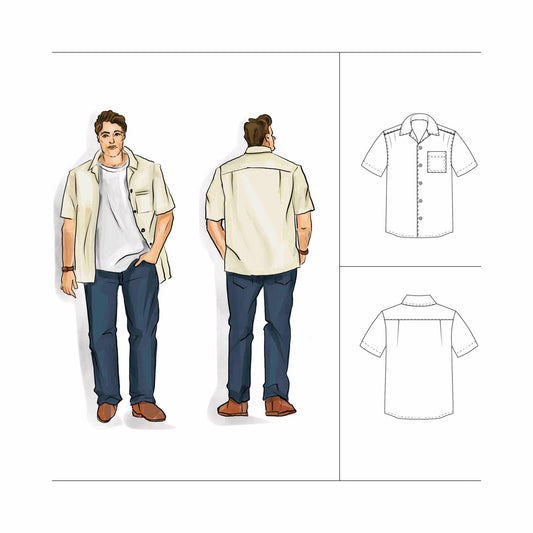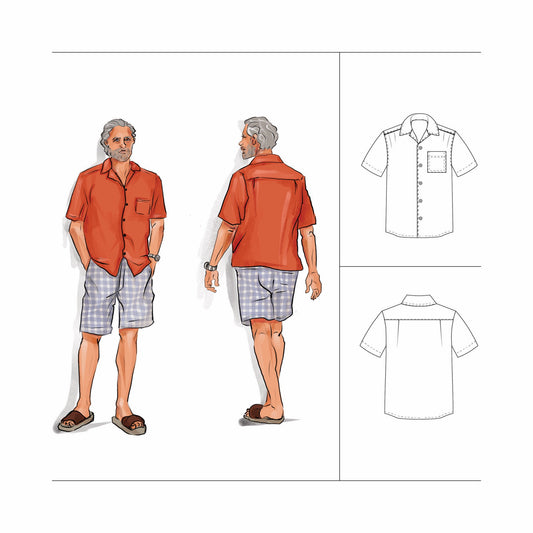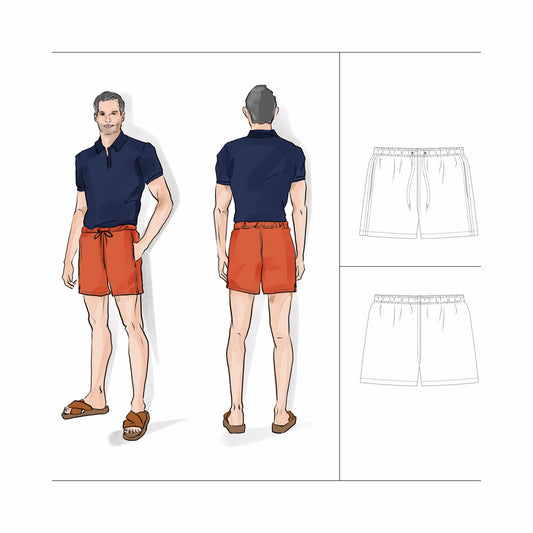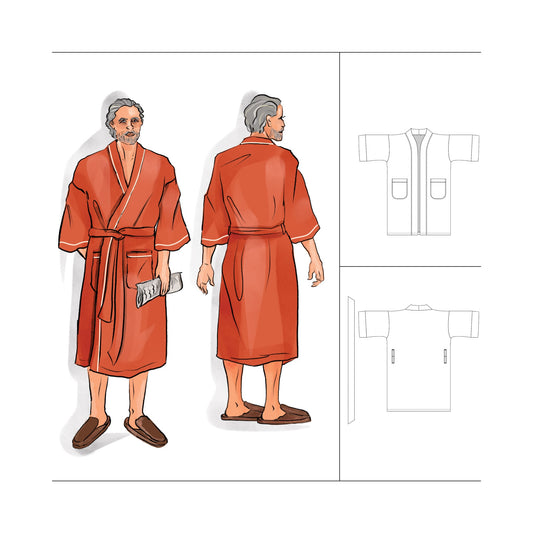Sewing is more than stitches and seams. It’s personal, creative, and deeply satisfying, but only when you understand how you work best. After years of sewing, I’ve come to realise that success in sewing isn’t just about skill, it’s about mindset, method, and meaning. (love a little alliteration)
Whether you’re stuck staring at your fabric stash, unsure what to make next, or wondering why a project didn’t quite turn out how you envisaged, these are the five things I wish every sewer knew.
They’ve changed how I sew and how I feel about what I make. I think they’ll do the same for you.
Topics covered in this article are:
- Your colours matter
- You bring strengths to the table (that go beyond skill)
- The sewing pattern and fabric need to match
- Quick projects aren't 'less than' - they are strategic
- A finished garment is not the end - it is the middle

Key Takeaways
1. Know yourself to sew well
Your Colour Type, strengths, and sewing style shape everything you make. When they align, your garments look better, feel better and actually get worn.
2. Small wins matter
Quick projects boost motivation, build skills, and make use of scraps. They’re not shortcuts. They are smart strategy.
3. Creativity follows a rhythm
Sewing works best when you follow the full creative cycle, from inspiration to rest. Skip a step, and you’ll likely feel stuck.
1. Your Colours Matter (More Than You Think)
When you sew your own clothes or create something for someone else you have complete control over the fabric. That’s a gift most people don’t realise they have. But here’s the catch: many sewers choose colours based on what’s trendy or what looks nice on the roll, or what they have always worn without checking what really suits their personal colouring.
The result? Beautifully made garments that never get worn or if they do they don't make the most of their beautiful faces.
Research shows that people form impressions within the first seven seconds of meeting someone. Research also says that those first impressions are unreliable and often inaccurate.
Don't add to the misconceptions with bad colour, style, fit and texture choices. Wearing colours that harmonise with your skin tone, hair, and eyes can instantly make you look healthier, more vibrant, and more polished. And that is a first impression worth sharing and is someone people love hanging around. (think Rohn's theory)
It is the reason I developed the Fabric Formula. I spent months dissecting all the colour theory to put it into a modern format that was easy to understand and importantly usable.
My husband is even referring to it!
It’s the tool I wish I had years ago when I was sewing beautiful things that just didn’t feel quite right - like a bright purple and red silk pant suit I made for a wedding. If you’re tired of second-guessing your fabric choices, this guide is your next step.
2. You Bring Strengths to the Table (That Go Beyond Skill)
Many people think sewing success is all about technical ability, but I’ve learned that mindset and personality play an even bigger role.
Your strengths shape how you approach a sewing project. Some people love planning every detail. Others thrive on spontaneity and problem-solving on the fly. Recognising your natural strengths helps you sew in a way that feels more like you and that’s where the magic happens.
According to research from the VIA Institute on Character, individuals who use their signature strengths experience higher levels of happiness and well-being.
It is the reason I taught it to 100s of tweens and teens when I was running Dreaming Big for Little Girls.
My top five strengths are:
- Judgment - I like to think things through, not at my best when put on the spot
- Appreciation of beauty and excellence - I seek out excellence in people, places, animals and things and value the beauty they bring to the world)
- Honesty - I seek truth and presenting myself in a genuine way
- Forgiveness - accepting, giving people the benefit of the doubt and not being vengeful
- Creativity - Thinking of novel and productive ways to conceptualise and do things
If I am not tapping into one or more of these strengths in my actions and words it feels unfulfilling.
When you align your projects with your personal strengths, whether that’s persistence, creativity, curiosity, or attention to detail you’re more likely to enjoy the process and finish with something you’re proud of.
If you're curious about how your strengths show up in sewing, I’ve written a blog that explores this in more depth and I created a quiz for you to get you started.
I encourage you to do the VIA Strength Assessment. It's an eye-opener, especially if you have ever compared yourself to others and wondered why their process seems so effortless. It’s not magic. It’s alignment.

Via Character Strengths 6 Pillars
3. The Pattern Isn’t the Problem, But It Might Not Be the Best Match For The Fabric
Have you ever started sewing a pattern that looked amazing on the envelope… only to be disappointed halfway through?
It might not be the pattern or your skills. Often, the real issue is the fabric and sewing pattern pairing. Certain fabrics don’t behave well with certain silhouettes. A structured jacket in a flowy rayon? A tailored shirt in a terry towelling, maybe not. But a Camp Collar Shirt in Terry - that looks cool.
That wrong fabric type is a recipe for frustration.
I often see in forums and sewing groups, sewists sharing a picture of the sewing pattern and asking long time sewers for fabric type advice "What should I make this out of?".
Experienced sewers often report that the wrong fabric choice can lead to dissatisfaction with the final garment. Understanding which fabrics complement which garment types and matching them to the style or purpose of the garment comes with trial and error, but asking for advice can make the sewing process smoother and more enjoyable.
That’s why I’ve created guides and blog posts and even a GPT Wizard focused on fabric and pattern pairing so you don’t have to learn the hard way like I did. If you’ve ever thought “I’ll never sew this pattern again,” it might be time to revisit it with a better-matched fabric.
A List of Blog Posts about Fabric and Pattern Pairing
4. Quick Projects Aren’t ‘Less Than’ — They Are Strategic
There’s a common misconception that real sewers only sew big projects: jackets, trousers, or full wardrobes. But honestly? Quick projects like bow ties, bucket hats, or pocket squares can be incredibly valuable.
They give you a fast sense of completion, build confidence, and help you practise new techniques on a smaller scale.
In fact, productivity research shows that completing small tasks releases dopamine and creates a positive feedback loop, which keeps you motivated to tackle more complex goals.
It’s not cheating; it’s smart.
These projects also use up those awkward-sized scraps you’ve been saving, and they’re perfect for spontaneous sewers who get inspired in the moment.
So next time you feel like you “should” be sewing something bigger, consider starting small instead. I offer several patterns specifically designed to be finished in a morning. They’re perfect for gifts, skill-building, or simply enjoying the process without overwhelm.
5. A Finished Garment Is Not the End – It’s the Middle
Sewing doesn’t begin when the needle hits the fabric or end when you tie off the last thread. It’s part of a deeper creative process, and when you understand that rhythm, everything becomes more meaningful and less stressful.
The process I teach includes five stages: Saturate, Percolate, Create, Celebrate, and Rejuvenate.
Each stage has a purpose:
Saturate: is when you gather inspiration and define the problem
Percolate: is when you align those ideas with your strengths and values so the project feels right
Create: sew the garment - bring it to life
Celebrate: the moment and meaning behind it. Celebrating with the people whose opinion you value along the way, not just at the end. Admire your handy work as it walks out the door to the next party.
Rejuvenate: rest, reflect, and let new ideas emerge.
Skipping or rushing these stages often leads to burnout or unfinished projects.

Frequently Asked Questions
1. What’s a Colour Type and why does it matter when sewing?
Your Colour Type reflects the tones that suit your skin undertone, hair, and eyes among other things. When you sew in colours that harmonise with you, the garment looks more flattering and you are more likely to wear it.
2. What if I don’t feel creative, can I still follow the 5-step process?
Yes. The creative process isn’t just for “artistic” people. It’s a structure that helps anyone make thoughtful, original work. Even planners and practical thinkers benefit from it.
3. I’ve had a few sewing fails, how do I know if it’s the pattern or the fabric?
Often, it’s the pairing. Some fabrics don’t behave well with certain patterns. Check out my Pattern & Fabric Pairing guides to avoid these mismatches. I link to a number of the blogs in this article.
4. How do I know what kind of sewer I am?
Take the free Sewing Style Quiz to discover whether you’re a Planner, Creative Maker, or Spontaneous Sewer. It helps explain how you make decisions and how to make sewing easier for your style. I send you a report with suggested next steps when you are done.
Final Thoughts
I have found sewing is so much more than following instructions.
It’s a reflection of your choices, your creativity, and the way you express care, both for yourself and the people you sew for. When you understand your colours, your strengths, and your process, sewing becomes even more joyful and infinitely more you.











